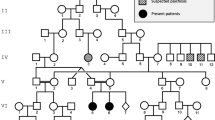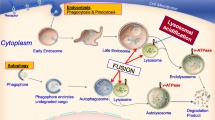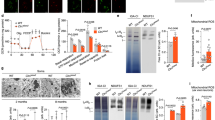Abstract
Neuronal ceroid lipofuscinoses (NCLs) are a group of lysosomal storage diseases characterized by neurological impairment and blindness. NCLs are almost always due to single mutations in different genes (CLN1–CLN8). Ubiquitous accumulation of undigested material and of a hydrophobic inner mitochondrial membrane protein, the subunit c of mitochondrial ATP synthase, has been described. Although protein mutation(s) in the endoplasmic reticulum–lysosomes axis can modify the trafficking and the recycling of different molecules, one of the upstream targets in these diseases may be represented by the balance of gene expression. To understand if and how neurons modify the levels of important genes during the first phases of the disease, it is important to characterize the mechanisms of neurodegeneration. Due to the impossibility of performing this analysis in humans, alternative models of investigation are required. In this study, a mouse model of human NCL8, the mnd mouse has been employed. The mnd mice recapitulate many clinical and histopathological features described in NCL8 patients. In this study, we found an altered expression of different genes in both central and peripheral organs associated with lipopigment accumulation. This is a preliminary approach, which could also be of interest in providing new diagnostic tools for NCLs.







Similar content being viewed by others
Abbreviations
- NCL:
-
Neuronal ceroid lipofuscinosis
- SSH:
-
Suppression subtractive hybridization
- MS:
-
Multiple sclerosis
- MBP:
-
Myelin basic protein
References
Mole SE, Williams RE, Goebel HH (2005) Correlations between genotype, ultrastructural morphology and clinical phenotype in the neuronal ceroid lipofuscinoses. Neurogenetics 6:107–126
Haltia M (2003) The neuronal ceroid-lipofuscinoses. J Neuropathol Exp Neurol 62:1–13
Ranta S, Zhang Y, Ross B et al (1999) The neuronal ceroid lipofuscinoses in human EPMR and mnd mutant mice are associated with mutations in CLN8. Nat Genet 23:233–236
Messer A, Plummer J, Wong V, Lavail MM (1993) Retinal degeneration in motor neuron degeneration (mnd) mutant mice. Exp Eye Res 57:637–641
Guarneri R, Russo D, Cascio C et al (2004) Retinal oxidation, apoptosis and age- and sex-differences in the mnd mutant mouse, a model of neuronal ceroid lipofuscinosis. Brain Res 1014:209–220
Messer A, Plummer J (1993) Accumulating autofluorescent material as a marker for early changes in the spinal cord of the Mnd mouse. Neuromuscul Disord 3:129–134
Pardo CA, Rabin BA, Palmer DN, Price DL (1994) Accumulation of the adenosine triphosphate synthase subunit C in the mnd mutant mouse. A model for neuronal ceroid lipofuscinosis. Am J Pathol 144:829–835
Bertamini M, Marzani B, Guarneri R et al (2002) Mitochondrial oxidative metabolism in motor neuron degeneration (mnd) mouse central nervous system. Eur J Neurosci 16:2291–2296
Traina G, Federighi G, Macchi M, Bernardi R, Durante M, Brunelli M (2011) Modulation of myelin basic protein gene expression by acetyl-L -carnitine. Mol Neurobiol 44:1–6
Traina G, Valleggi S, Bernardi R et al (2004) Identification of differentially expressed genes induced in the rat brain by acetyl-L-carnitine as evidenced by suppression subtractive hybridisation. Brain Res Mol Brain Res 132:57–63
Traina G, Bernardi R, Cataldo E, Macchi M, Durante M, Brunelli M (2008) In the rat brain acetyl-L-carnitine treatment modulates the expression of genes involved in neuronal ceroid lipofuscinosis. Mol Neurobiol 38:146–152
Bigini P, Mennini T (2004) Immunohistochemical localization of TNFalpha and its receptors in the rodent central nervous system. Methods Mol Med 98:73–80
Mennini T, Bigini P, Cagnotto A et al (2004) Glial activation and TNFR-I upregulation precedes motor dysfunction in the spinal cord of mnd mice. Cytokine 25:127–135
Faust JR, Rodman JS, Daniel PF, Dice JF, Bronson RT (1994) Two related proteolipids and dolichol-linked oligosaccharides accumulate in motor neuron degeneration mice (mnd/mnd), a model for neuronal ceroid lipofuscinosis. J Biol Chem 269:10150–10155
Sun-Wada GH, Wada Y, Futai M (2003) Lysosome and lysosome-related organelles responsible for specialized functions in higher organisms, with special emphasis on vacuolar-type proton ATPase. Cell Struct Funct 28:455–463
Sun-Wada GH, Wada Y, Futai M (2003) Vacuolar H+ pumping ATPases in luminal acidic organelles and extracellular compartments: common rotational mechanism and diverse physiological roles. J Bioenerg Biomembr 35:347–358
Kasper D, Planells-Cases R, Fuhrmann JC et al (2005) Loss of the chloride channel ClC-7 leads to lysosomal storage disease and neurodegeneration. EMBO J 24:1079–1091
Nijssen PC, Ceuterick C, van Diggelen OP et al (2003) Autosomal dominant adult neuronal ceroid lipofuscinosis: a novel form of NCL with granular osmiophilic deposits without palmitoyl protein thioesterase 1 deficiency. Brain Pathol 13:574–581
Palmer DN, Barns G, Husbands DR, Jolly RD (1986) Ceroid lipofuscinosis in sheep. II. The major component of the lipopigment in liver, kidney, pancreas, and brain is low molecular weight protein. J Biol Chem 261:1773–1777
Boriack RL, Cortinas E, Bennett MJ (1995) Mitochondrial damage results in a reversible increase in lysosomal storage material in lymphoblasts from patients with juvenile neuronal ceroid-lipofuscinosis (Batten Disease). Am J Med Genet 57:301–303
Woloszynek JC, Coleman T, Semenkovich CF, Sands MS (2007) Lysosomal dysfunction results in altered energy balance. J Biol Chem 282:35765–35771
Baumann N, Pham-Dinh D (2001) Biology of oligodendrocyte and myelin in the mammalian central nervous system. Physiol Rev 81:871–927
Quarles RH (1997) Glycoproteins of myelin sheaths. J Mol Neurosci 8:1–12
Tansey FA, Farooq M, Cammer W (1991) Glutamine synthetase in oligodendrocytes and astrocytes: new biochemical and immunocytochemical evidence. J Neurochem 56:266–272
Lamers KJ, Vos P, Verbeek MM, Rosmalen F, van Geel WJ, van Engelen BG (2003) Protein S-100B, neuron-specific enolase (NSE), myelin basic protein (MBP) and glial fibrillary acidic protein (GFAP) in cerebrospinal fluid (CSF) and blood of neurological patients. Brain Res Bull 61:261–264
Cooper JD, Messer A, Feng AK, Chua-Couzens J, Mobley WC (1999) Apparent loss and hypertrophy of interneurons in a mouse model of neuronal ceroid lipofuscinosis: evidence for partial response to insulin-like growth factor-1 treatment. J Neurosci 19:2556–2567
Melo T, Bigini P, Sonnewald U et al (2010) Neuronal hyperexcitability and seizures are associated with changes in glial-neuronal interactions in the hippocampus of a mouse model of epilepsy with mental retardation. J Neurochem 115(6):1445–1454
Mennini T, Bigini P, Ravizza T et al (2002) Expression of glutamate receptor subtypes in the spinal cord of control and mnd mice, a model of motor neuron disorder. J Neurosci Res 70:553–560
Elger B, Schneider M, Winter E et al (2006) Optimized synthesis of AMPA receptor antagonist ZK 187638 and neurobehavioral activity in a mouse model of neuronal ceroid lipofuscinosis. ChemMedChem 1:1142–1148
Mennini T, Cagnotto A, Carvelli L et al (1999) Biochemical and pharmacological evidence of a functional role of AMPA receptors in motor neuron dysfunction in mnd mice. Eur J Neurosci 11:1705–1710
Macauley SL, Wozniak DF, Kielar C, Tan Y, Cooper JD, Sands MS (2009) Cerebellar pathology and motor deficits in the palmitoyl protein thioesterase 1-deficient mouse. Exp Neurol 217:124–135
Williams RE, Aberg L, Autti T, Goebel HH, Kohlschutter A, Lonnqvist T (2006) Diagnosis of the neuronal ceroid lipofuscinoses: an update. Biochim Biophys Acta 1762:865–872
Reolon GK, Reinke A, de Oliveira MR et al (2009) Alterations in oxidative markers in the cerebellum and peripheral organs in MPS I mice. Cell Mol Neurobiol 29:443–448
Manca V, Kanitakis J, Zambruno G, Thivolet J, Gonnaud PM (1990) Ultrastructural study of the skin in a case of juvenile ceroid-lipofuscinosis. Am J Dermatopathol 12:412–416
Acknowledgments
Authors are very grateful to Dr. Katia Paolella for her technical help. The authors thank Dr. James Neil Fisher for help with manuscript editing.
Author information
Authors and Affiliations
Corresponding author
Additional information
G. Traina and P. Bigini equally contributed to this work.
Rights and permissions
About this article
Cite this article
Traina, G., Bigini, P., Federighi, G. et al. Lipofuscin Accumulation and Gene Expression in Different Tissues of mnd Mice. Mol Neurobiol 45, 247–257 (2012). https://doi.org/10.1007/s12035-012-8248-y
Received:
Accepted:
Published:
Issue Date:
DOI: https://doi.org/10.1007/s12035-012-8248-y




